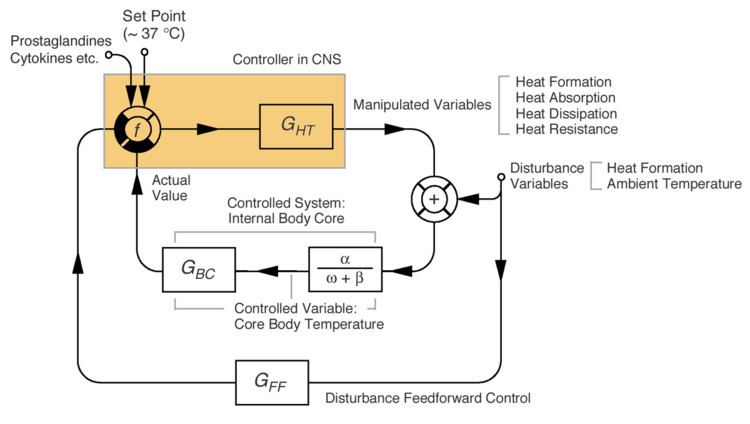 | ||
As in other mammals, thermoregulation in humans is an important aspect of homeostasis. In thermoregulation, body heat is generated mostly in the deep organs, especially the liver, brain, and heart, and in contraction of skeletal muscles. Humans have been able to adapt to a great diversity of climates, including hot humid and hot arid. High temperatures pose serious stresses for the human body, placing it in great danger of injury or even death. For humans, adaptation to varying climatic conditions includes both physiological mechanisms resulting from evolution and behavioural mechanisms resulting from conscious cultural adaptations.
Contents
- Control system
- In hot conditions
- In hot and humid conditions
- In cold conditions
- Uses of Hypothermia
- Related diseases and syndromes
- Human heat output power
- References
There are four avenues of heat loss: convection, conduction, radiation, and evaporation. If skin temperature is greater than that of the surroundings, the body can lose heat by radiation and conduction. But, if the temperature of the surroundings is greater than that of the skin, the body actually gains heat by radiation and conduction. In such conditions, the only means by which the body can rid itself of heat is by evaporation. So, when the surrounding temperature is higher than the skin temperature, anything that prevents adequate evaporation will cause the internal body temperature to rise. During sports activities, evaporation becomes the main avenue of heat loss. Humidity affects thermoregulation by limiting sweat evaporation and thus heat loss.
Control system
The core temperature of a human is regulated and stabilized primarily by the hypothalamus, a region of the brain linking the endocrine system to the nervous system, and more specifically by the anterior hypothalamic nucleus and the adjacent preoptic area regions of the hypothalamus. As core temperature varies from the set point, endocrine production initiates control mechanisms to increase or decrease energy production/dissipation as needed to return the temperature toward the set point (see figure).
In hot conditions
In hot and humid conditions
In general, humans appear physiologically well adapted to hot dry conditions. However, effective thermoregulation is reduced in hot, humid environments such as the Red Sea and Persian Gulf (where moderately hot summer temperatures are accompanied by unusually high vapor pressures), tropical environments, and deep mines where the atmosphere can be water-saturated. In hot-humid conditions, clothing can impede efficient evaporation. In such environments, it helps to wear light clothing such as cotton, that is pervious to sweat but impervious to radiant heat from the sun. This minimizes the gaining of radiant heat, while allowing as much evaporation to occur as the environment will allow. Clothing such as plastic fabrics that are impermeable to sweat and thus do not facilitate heat loss through evaporation can actually contribute to heat stress.
In cold conditions
Uses of Hypothermia
Adjusting the human body temperature downward has been used therapeutically, in particular, as a method of stabilizing a body following trauma. It has been suggested that adjusting the A1 receptor of the hypothalamus may allow humans to enter a hibernation-like state of reduced body temperature, which could be useful for applications such as long-duration space flight.
Related diseases and syndromes
Human heat output power
Humans output from 70 watts to 870 watts, depending on the amount of physical activity undertaken.
